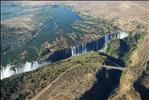
Victoria Falls
( 1 user review )No doubt about it, Mosi-oa-Tunya (meaning "The Smoke That Thunders") -- but more commonly known as Victoria Falls -- is one of the most amazing sights in the world. Just a few miles outside Livingstone and Victoria Falls (Zimbabwe), the Falls are twice as tall as Niagara Falls, and several times longer.
Understand
The big question is which side - Zambia or Zimbabwe? - the answer is quite simply Zimbabwe - If you are traveling through Zambia then Zimbabwe's reputation may put you off - but it shouldn't - although the US$30 visa and US$20 entry fee (US$10 for SADC residents) to the Falls may do more to deter you if you are only coming over for the day. Still it is another African country to brag about visiting and the visa has an impressive hologram on it! That said, the money from the visa may well go to support the Mugabe government.
Victoria Falls is CASH ONLY. Furthermore, there are NO ATMs that accept foreign cards in the Victoria Falls area. If you are out of cash, you will have to go to Zambia to withdraw, and will likely have to exchange Zambian Kwachas for US Dollars or South African Rands. Do NOT get stuck without adequate cash on hand.
History
It took thousands of years of erosion for Victoria Falls to appear as and where it does now. Mosi-oa-Tunya, or "the smoke that thunders” only became known to the western world as Victoria Falls after David Livingstone first set eyes on this astonishing natural wonder in 1855, a heartbeat ago in geological time.
How the Falls Were Formed
During the Jurassic Period (150 - 200 million years ago) volcanic activity resulted in thick basalt deposits covering large parts of Southern Africa. As the lava cooled and solidified, cracks appeared in the hard basalt crust, which were filled with clay and lime. Erosion and the course of the mighty Zambezi River cut through these softer materials, forming the first of a series of waterfalls. Over at least 2,000 years, the Falls have receded 8km upstream, as the Zambezi carved its way through seven gorges. This geological history can be seen in the dark basalt in the series of rocky gorges below the Falls. It is guessed that the Devil's Cataract, which is presently the lowest point of Victoria Falls, will eventually become the next gorge as the river continues to cut its way back upstream.
Dr. David Livingstone, I Presume
Scottish missionary David Livingstone first heard about Victoria Falls, known as Mosi-oa-Tunya, a full four years before he arrived there. The area was a sacred site for the Batoka and other local tribes. On the 17th of November 1855 Chief Sekeletu of the Makololo paddled Livingstone to an island in the Zambezi, known as Goat Island. Although the water was low at the time, it's little wonder that he felt a "tremor of fear" as he approached the wall of spray.
Gazing down into the churning chasm below must have been a heart-stopping experience (you can still make your way out to the island - now called Livingstone Island - during the dry season).Rumours abound that a Portuguese man beat him to it, but the evidence for this is scarce, so the first official description of the Falls, as penned by Livingstone, follows: "No one can imagine the beauty of the view from anything witnessed in England. It had never been seen before by European eyes; but scenes so lovely must have been gazed upon by angels in their flight."
The Railway Bridge
The discovery of coal in Hwange and reports of copper in Northern Rhodesia (now Zambia) brought an influx of people into the area around the Falls. The Victoria Falls Bridge was commissioned by Cecil John Rhodes in 1900, as part of his ambitious plan to build a Cape to Cairo railway. The railway line never made it as far as Cairo, but the bridge was completed in 1905, opening up the area to colonisation. An interesting snippet of information about the railway bridge is that the first living creature to cross it was a leopard.
History
It took thousands of years of erosion for Victoria Falls to appear as and where it does now. Mosi-oa-Tunya, or "the smoke that thunders” only became known to the western world as Victoria Falls after David Livingstone first set eyes on this astonishing natural wonder in 1855, a heartbeat ago in geological time.
Getting there
ACCESS to Victoria Falls Zimbabwe is assured with 24 international flights every week – 21 from Johannesburg and three from Namibian capital, Windhoek. These are complemented by a daily flight from Harare by Air Zimbabwe, plus a good road network from the South African border at Beit Bridge right through to the Falls. Additionally Air Botswana flies into Kasane, Chobe, just a 90-minute road transfer (and often a game drive itself) to the Falls and BA Comair and SAA all fly into Livingstone, Zambia, just a 30-minute transfer across the bridge border into Zimbabwe. And Air Zimbabwe is gearing up for the building momentum – they have approval to buy four more modern jets – two 767s and two 737s.
See
The park is open year-round, but you will get a much different experience depending on the season in which you visit.
-
In the rainy season (November to March), the water volume will be higher and the Falls will be more dramatic. You are guaranteed to get wet if you cross the bridge or walk along the trails winding near the Falls. On the other hand, it is precisely because the volume of water is so high that your viewing of the actual Falls will be obscured -- by all the water!
-
In the dry season, (April to October), the water volume will be lower, and Victoria Falls might just be a trickle. You will get a clearer view of the rocky ledge beneath the Falls, which is pretty spectacular unto itself, but "the Falls" might be somewhat underwhelming.
There are some great hotels in Livingstone (Zambian side). There are some expensive resorts that are operated by Sun International, but various others a little distance from the falls.
Things to do
-
Upper Zambezi Canoe Safari
-
Golfing
-
Visit the Wild Horizons Wildlife Sanctuary and Orphanage
-
Bungee
-
White water rafting (Grade 5, Grade 6 being commercially un-runable!)
-
Cruise up the Zambezi upstream of the falls. This is a must do. Utterly beautiful.
-
Take a microlight flight over the falls.
-
Experience a Wild Horizons Elephant Back Safari
-
Craft shopping in Vic Falls Town. Be prepared to bargain hard.
-
Gorge Swing! Zip Line! Flying Fox or Abseil
-
Experience the Steam Train Bridge Run at Sunset
-
A Full Day Trip to Chobe
-
Horse Riding
-
lion encounter experence
-
helle copter ride
Things to do
-
Upper Zambezi Canoe Safari
-
Golfing
-
Visit the Wild Horizons Wildlife Sanctuary and Orphanage
-
Bungee
-
White water rafting (Grade 5, Grade 6 being commercially un-runable!)
-
Cruise up the Zambezi upstream of the falls. This is a must do. Utterly beautiful.
-
Take a microlight flight over the falls.
-
Experience a Wild Horizons Elephant Back Safari
-
Craft shopping in Vic Falls Town. Be prepared to bargain hard.
-
Gorge Swing! Zip Line! Flying Fox or Abseil
-
Experience the Steam Train Bridge Run at Sunset
-
A Full Day Trip to Chobe
-
Horse Riding
-
lion encounter experence
-
helle copter ride
Eat
There is no food available within the park--bring it in yourself if you need something. Also, the monkeys within Victoria Falls will try to snatch your food if you are not paying attention to it.
-
The Boma – Place of Eating
-
Makuwa-Kuwa at the Victoria Falls Safari Lodge
-
Palm Restaurant at Ilala Lodge
-
Livingstone Room at the Victoria Falls Hotel
-
Jungle Junction at the Victoria Falls Hotel
Drink
There are no "official" stops for drinks within the park (except for one drinking fountain, but drink at your own risk--the monkeys play in it), so prepare yourself by bringing drinks in advance. Directly across the street from the entrance are stands that sell drinks. A 500mL water bottle is only US$1. Inside the park you may find a single person selling some drinks as well, also for US$1.
Sleep
It is not possible to sleep or dine in the park. Most people sleep in either Livingstone -- in Zambia -- or Victoria Falls -- in Zimbabwe.
Victoria Falls (Zimbabwe)
-
Amadeus Garden owner managed lodge B&B style just 2km from the Falls, comprising of eleven bedrooms set around a courtyard; lush gardens and swimming pool. They do transfers from the airports in Vic Falls and Livingstone, Zambia. www.amadeusgarden.com
-
Sprayview Hotel is about 2 km from the falls and overs accommodation from US$100.
-
Drifter Inn Victoria Falls - only 20 minutes by foot from the falls, this simple but quiet inn offers rooms from US$50 p.p.
-
Victoria Falls Safari Lodge - located in the immediate neighbourhood of the falls this lodge even includes a casino and is beautifully decorated in a safari-style. You can also have a good lunch here, while romms are available from US$150/pp.
-
Imbabala Zambezi Safari Lodge is carefully situated on a riverine fringe of the mighty Zambezi River where Zimbabwe, Botswana, Zambia and Namibia converge. Located 80 kilometers west of Victoria Falls, access is by transfer from Victoria Falls, Livingstone or Kasane. Imbabala offers not only the chance to unwind but also some of the most amazing game viewing and bird watching in the region, in the seclusion of a private National Parks concession. The 5,000 acre concession has 14 kilometers of private Zambezi river frontage and borders the Chobe Forest Reserve, which is renowned for its massive Elephant population. Herds of up to 1500 elephants have been seen on the floodplains below the Lodge!
-
The Kingdom Hotel Victoria Falls, . - In the depths of Zimbabwe, deep in the heart of the powerful Victoria Falls, you’ll find an architectural masterpiece, designed in the style of the Great Ruins of Zimbabwe. This four-star themed resort is fit for royalty,from US$150/pp.
Livingstone
-
Waterberry Lodge. - about 15 km from the falls and 28 km from Livingstone itself, direclty located on the banks of the Zambesi river. All huts have garden view. Price from US$80/pp.
-
The Zambezi Sun - one of the well-known hotels near the falls with different kinds of accommodation and restaurant.
-
Stanley Safari Lodge, . - One of the top adresses near the falls with wonderful views on the Zambesi river, the falls itself and a waterhole that elephants regularly visit.
-
David Livingstone Safari Lodge, . - The banks of the mighty Zambezi have welcomed a breathtaking two-story 77-roomed hotel, comprising 72 river facing rooms and 5 luxurious suites. Historical English elements reflect in lofty scale with the rawness of texture, stone, wood and earth, contrasting with the richness of exotic gold, bronze, copper and ivory, once traded through ancient Arab routes. Price from US$150/pp.
Contact & location
1 Review
Add your review
The photos displayed on this page are the property of one of the following authors:
name_1199, name_772, name_775, name_426, name_853, name_3813
Some photos courtesy of:
 . The photos provided by Flickr are under the copyright of their owners.
. The photos provided by Flickr are under the copyright of their owners.
This travel guide also includes text from Wikitravel articles, all available at  View full credits
View full credits
Ryan HollidayKevin Gabbert, David, Jim DeLaHunt, Go2Africa, Todd VerBeek, Philipp Sch., Tom Holland, Nic Roets, Michele Ann Jenkins, Jani Patokallio and Willy Volk, Inas, Rodericoco and Hypatia
This travel guide also includes text from Wikipedia articles, all available at  View full credits
View full credits












I liked
your collection is the best selectionI disliked
Nothing